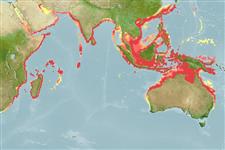Common names from other countries
Environment: milieu / climate zone / depth range / distribution range
Ecologia
marinhas demersal; intervalo de profundidade 7 - 200 m (Ref. 4417). Tropical; 30°N - 35°S, 24°E - 154°E
Indian Ocean: throughout the region including the Red Sea and Persian Gulf; south to Algoa Bay in South Africa (Ref. 4417). Western Pacific: Taiwan southward to New Guinea and extending to the northeastern coast of Australia.
Tamanho / Peso / Idade
Maturity: Lm ? range ? - ? cm
Max length : 37.5 cm TL macho/indeterminado; (Ref. 117081); common length : 15.0 cm SL macho/indeterminado; (Ref. 9774); peso máx. publicado: 760.00 g (Ref. 117081)
Espinhos dorsais (total) : 0; Raios dorsais (total) : 67 - 74; Espinhos anais: 0; Raios anais : 52 - 66. Eyed side with dark rings arranged in about 5 longitudinal rows; dark blotch at junction of straight and curved parts of lateral line and 2 smaller ones on the lateral line at posterior part of body and anterior end of caudal peduncle; small dark spots and elongate markings on median fins; pectoral fins with 10-12 rays on eyed side, 10-11 rays on blind side (Ref. 4417).
Found on clay, sand and mud bottoms of the continental shelf. Feeds on benthic animals (Ref. 5213). Mainly sold fresh.
Ciclo de vida ou comportamento de acasalamento
Maturities | Reprodução | Spawnings | Egg(s) | Fecundities | Larvas
Distinct pairing (Ref. 205).
Nielsen, J.G., 1984. Bothidae. In W. Fischer and G. Bianchi (eds.) FAO species identification sheets for fishery purposes. Western Indian Ocean fishing area 51. Vol. 1. FAO, Rome. pag. var. (Ref. 3322)
Status na Lista Vermelha da UICN (Ref. 130435)
CITES (Ref. 128078)
Not Evaluated
Ameaça para os humanos
Harmless
Uso pelos humanos
Pescarias: espécies comerciais
Ferramentas
Warning: mysqli::__construct(): (HY000/1040): Too many connections in /var/www/html/includes/speciessummary.lib.php on line 2104
Can't connect to MySQL database fbquizv2. Errorcode: Too many connections
